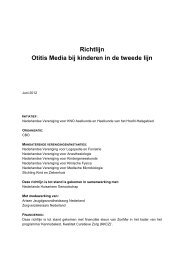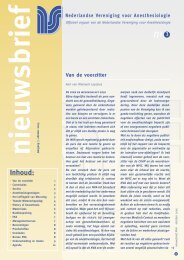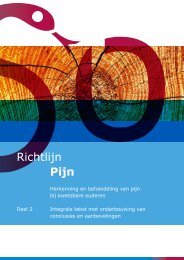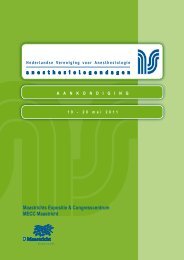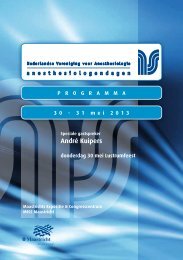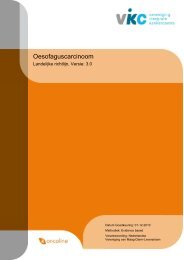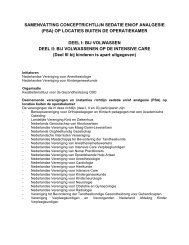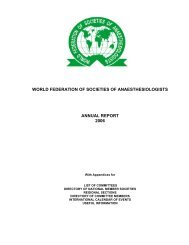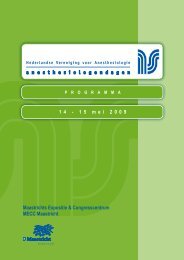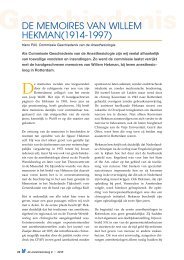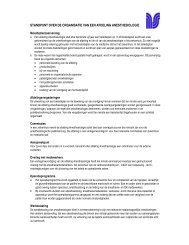Sedatie en/of analgesie (PSA) bij kinderen - Nederlandse ...
Sedatie en/of analgesie (PSA) bij kinderen - Nederlandse ...
Sedatie en/of analgesie (PSA) bij kinderen - Nederlandse ...
- No tags were found...
Create successful ePaper yourself
Turn your PDF publications into a flip-book with our unique Google optimized e-Paper software.
- E<strong>en</strong> <strong>PSA</strong> van e<strong>en</strong> kind waar<strong>bij</strong> tev<strong>en</strong>s nog passieve <strong>of</strong> actieve fixatie <strong>of</strong> immobilisatiewordt toegepast om het kind te bedwing<strong>en</strong> <strong>en</strong>/<strong>of</strong> de procedure mogelijk te mak<strong>en</strong>,moet beschouwd word<strong>en</strong> als e<strong>en</strong> niet-effectieve <strong>en</strong> niet toelaatbare vorm van <strong>PSA</strong>.- Bij kinder<strong>en</strong> met e<strong>en</strong> verstandelijke beperking <strong>en</strong> andere kinder<strong>en</strong> die moeilijk zijn voorte bereid<strong>en</strong> op handeling<strong>en</strong>/procedures <strong>en</strong> ook niet <strong>of</strong> nauwelijks zull<strong>en</strong> mee werk<strong>en</strong>,di<strong>en</strong><strong>en</strong> procedures <strong>bij</strong> voorkeur onder algehele anesthesie plaats te vind<strong>en</strong> zolang erge<strong>en</strong> e<strong>en</strong>voudiger alternatiev<strong>en</strong> voorhand<strong>en</strong> zijn.- Er moet werk word<strong>en</strong> gemaakt van e<strong>en</strong> duidelijke juridische, ethische <strong>en</strong> praktischeomkadering voor het gebruik van fixatie <strong>en</strong> immobilisatie zodat de pr<strong>of</strong>essional meerduidelijkheid krijgt over (1) zijn/haar verantwoordelijkheid <strong>bij</strong> deze handeling<strong>en</strong> <strong>en</strong> (2)de manier waarop immobilisatie <strong>en</strong> fixatie (indi<strong>en</strong> onontkoombaar) correct kunn<strong>en</strong>word<strong>en</strong> toegepast zonder daar<strong>bij</strong> de individuele behoeft<strong>en</strong> van het kind teveronachtzam<strong>en</strong>.51015202530Literatuur1. Blike GT, Cravero JP. Pride, prejudice, and pediatric sedation: A multidisciplinary Evaluation <strong>of</strong>the State <strong>of</strong> the Art. Dartmouth Summit on Pediatric Sedation 2001. National Pati<strong>en</strong>t SafetyFoundation - http://www.npsf.org/pdf/r/PediatricSedation.pdf2. Br<strong>en</strong>ner M. Child restraint in the acute setting <strong>of</strong> pediatric nursing: an extraordinarly stressfulmom<strong>en</strong>t. Issues in Compreh<strong>en</strong>sive Pediatric Nursing 2007;30:29-37.3. Charter <strong>of</strong> the European Association for Childr<strong>en</strong> in Hospital (EACH 2002) – www.each-for-sickchildr<strong>en</strong>.org4. Collins P. Restraining childr<strong>en</strong> for painful procedures. Paediatr. Nurs. 1999;11(3):14-16.5. Connick C, Palat M, Puliese S. The appropriate use <strong>of</strong> physical restraints:Considerations. JD<strong>en</strong>t Child 2000;67:256-262.6. Dorfman D, Mehta S. Restraint use for psychiatric pati<strong>en</strong>ts in the pediatric emerg<strong>en</strong>cydepartm<strong>en</strong>t. Pediatr Emerg Care. 2006;22:7-12.7. Dorfman D, Kastner B. The use <strong>of</strong> restraint for pediatric psychiatric pati<strong>en</strong>ts in emerg<strong>en</strong>cydepartm<strong>en</strong>ts. Pediatr Emerg Care. 2004;20:151-6.8. Dorfman D. The use <strong>of</strong> physical and chemical restraints in the pediatric emerg<strong>en</strong>cy departm<strong>en</strong>t.Pediatr.Emerg.Care 16[5], 355-360. 20009. Graham P, Hardy M. The immobilisation and restraint <strong>of</strong> pediatric pati<strong>en</strong>ts during plain filmradiographic examinations. Radiography 2004;10:23-31.10. Folkes K. Is restraint a form <strong>of</strong> abuse ? Paediatr. Nurs. 2005;17(6):41-4411. Hardy M <strong>en</strong> Armitage G.The child’s right to cons<strong>en</strong>t to x-ray and imagung investigations: issues<strong>of</strong> restraint and immobilization from a multidisciplinary perspective. Review. Journal <strong>of</strong> ChildHealth Care 2002;6:107-11912. Houpt M. Project USAP 2000 – Use <strong>of</strong> sedative ag<strong>en</strong>ts by pediatric d<strong>en</strong>tists: a 15-year follow upsurvey. Pediatr D<strong>en</strong>t 2002;24:289-29413. Internationale Verdrag inzake de Recht<strong>en</strong> van het Kind (Algem<strong>en</strong>e Vergadering van deVer<strong>en</strong>igde Naties 20 november 1989; van kracht in Nederland vanaf 8 maart 1995) –www.def<strong>en</strong>ceforchildr<strong>en</strong>.nl14. Jeffery K. Therapeutic restraint <strong>of</strong> childr<strong>en</strong>; it must always be justified. Paediatr. Nurs2002;14(9):20-2.Conceptrichtlijn <strong>Sedatie</strong> <strong>en</strong>/<strong>of</strong> <strong>analgesie</strong> (<strong>PSA</strong>)150 <strong>bij</strong> kinder<strong>en</strong> op locaties buit<strong>en</strong> de OK, 2009



